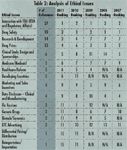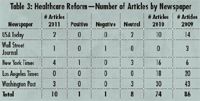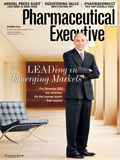Off the Hook? Pharm Exec's Annual Press Audit
Our annual press audit finds that the big news in 2011 for pharma was ... no news.
The big news in 2011 for pharma was ... no news. The year was the quietest for big daily newspaper coverage of the pharmaceutical industry since we began tracking the data in 2004. And since newspaper coverage of the industry has historically been more negative than positive, this "neglect" gives Big Pharma a respite—and a welcome chance to reinvent itself and repair its reputational credentials.

Coverage of the industry in print is at its lowest level since the Saint Joseph's study began in 2004-down 48.4 percent in 2011 from the previous year. (GETTY IMAGES / PETER AUGUSTIN)
Sponsored by the Arrupe Center for Business Ethics at Saint Joseph's University, the audit also found a less negative tone in coverage. Two issues drew the most attention: drug safety and the FDA regulatory environment.
Details of the findings include:
» Coverage of pharma is down 48.4 percent from last year and the lowest it has been since the study was launched in 2004.
» Coverage is less critical of the industry. In 2011, 21 percent of articles were negative toward the industry compared to a five-year average of 48 percent negative.
» Flu vaccines, which earned the top spot on the list of issues last year, dropped to 11th.
» Drug prices are receiving less media scrutiny, but are still on the radar screen, at fourth place on the list of issues.
» Merck, Roche, and Pfizer were the companies identified most frequently in the news.
» Healthcare reform coverage decreased by 88 percent, from last year's 86 articles to only 10.
Processing the News
The audit analyzed the top five newspapers in the United States as defined by circulation for a 12-month period and identified all front-page and editorial articles pertaining to "hot button" pharma issues. The purpose of the audit was to shed light on the following questions:
» What ethical and legal controversies face the pharma industry—and what kinds of coverage do they attract?
» Do the articles and headlines support or oppose the positions taken by the industry, as defined by the Pharmaceutical Research & Manufacturers' Association (PhRMA)?
» How often do reporters include the industry's perspective in the stories that cover the issues of the day?
» What pharmaceutical companies and brand names are identified and discussed in the articles?
» What are the implications of these findings for the industry?
» To be included in the study and in our EthicsTrak database, an article had to be published between October 1, 2010, and September 30, 2011, in one of the top five US newspapers (as measured by circulation): USA Today, Wall Street Journal, The New York Times, Los Angeles Times, and The Washington Post.
Table 1 (at right) shows the breakdown of coverage by newspaper. Coverage is down by a wide margin in all five newspapers, ranging from a drop of 31 percent in the Los Angeles Times to a 68 percent decline in USA Today.

Table 1: Number of Articles by Newspaper and Section
What Are the Hot Button Issues?
Table 2 identifies the issues covered in the articles, the frequency of their coverage, and how the results compare to previous years. At the top of the list of topics attracting media attention in 2011 are two issues related to drug safety. Scrutiny and criticism of "FDA and Regulatory Issues" was first on the list, which fits the pattern of previous years. Next up on the list is the related issue of "Drug Safety," another perennial focus of the media. With a combined total of 46 references in the 80 articles audited, these two issues, "FDA" and "Drug Safety," continue to dominate the news and reveal the continuing media scrutiny of the drug approval process, cases of misuse or abuse of prescription drugs, the impact of adverse events, and consumer lawsuits related to drug safety. As you might expect, most of those articles were critical of the industry and/or a specific pharma company or brand.

Table 2: Analysis of Ethical Issues
Third on the list was "Research and Development." This set of articles reported mostly good news about the industry, in the form of progress made in research and drug development for cancer, lupus, schizophrenia, AIDS, and advancements in diagnostic testing for head injuries and Alzheimer's disease.
The focus on high drug prices has ebbed and flowed over the eight years of the study. In the beginning years, drug prices were consistently at or near the top of the list of hot-button issues. Last year, the number of articles on drug prices dropped to sixth on the list, but this year it bounced back up again, to fourth place, just one article behind the focus on R&D. Furthermore, two related pricing issues—"Importation/Reimportation of Drugs" and "Differential Pricing and Distribution"—once a significant focus of media attention, make barely a blip on the screen now. Each received just one reference in 2011.
Flu vaccines dropped from the top of the list last year to a distant 11th place in 2011. In fact, flu vaccine articles were so prominent in 2010 that they received more than double the coverage of any other single pharma-related issue.
Surprisingly, healthcare reform was not a hot issue in 2011, at least not in comparison to 2010. As shown in Table 2, the 10 references about the pharmaceutical industry are divided evenly between "Healthcare Reform" and "Medicare/Medicaid," with five references each. Although there was far less newspaper coverage this year, the rankings of these issues only moved slightly when compared to last year. "Healthcare Reform" dropped from fifth in 2010 to sixth in 2011 and "Medicare/Medicaid" went from seventh in 2010 to sixth in 2011.
Coverage
A consistent finding throughout the eight-year study is that articles and headlines tend to be more negative than positive for the industry. The good news over the past two years, however, is that the proportion of both negative headlines and negative articles declined considerably from previous years. In fact, the analysis of full-text articles reveals a significant shift toward less negativity about the industry, to an almost equal balance of positive (17.5 percent) and negative articles (21.2 percent). Despite that bit of good news, headlines were still twice as likely to be negative (25 percent) than positive (12.5 percent) toward the industry.
Newspaper Coverage of Companies and their Products
A component of our audit is to track the number of times a pharmaceutical company and/or one of its products are mentioned. For example, if the company is mentioned by name once and two of its products are mentioned once apiece, then that would account for three mentions for that company. This is an excellent proxy for the amount of media attention, good or bad, the company received during the year.
This year there were 69 mentions that included 25 companies and 55 of their products. The most frequently mentioned company was Pfizer (Wyeth included) with 18. The 18 included nine mentions of the company by name and nine mentions for eight products: twice for Prempro and once for Aricept, Celebrex, crizotinib, Lyrica, Neurontin, Reglan, and torcetrapib (one of the industry's biggest disappointments). The anti-hypertensive caused mortality in the treatment group receiving a combination of torcetrapib and atorvastatin (Lipitor) during Phase III clinical studies in 2006.
Genentech was second with 13 mentions; four for the company and nine for three of their products: Avastin, Rituxan, and Herceptin. Avastin was the most mentioned product with seven due to concerns about the drug's link to blindness when used off-label to treat macular degeneration and about FDA's withdrawal of its approval of Avastin for breast cancer.
GlaxoSmithKline and Merck were tied for third with 11 mentions. For GSK, three identified the company by name and eight identified six products by name: Avandia and Paxil each had two, and Bactroban, Coreg, Tagamet, and Welbutrin each had one. For Merck, there were seven mention of the company by its name and four for its products: Gardasil, Varivax, Vioxx, and Zostavax. Roche and Johnson & Johnson (McNeil included) were fourth and had nine mentions apiece. Roche's mentions were a combination of the company name (five times) and product names (three times; one each for Orlistat, Plexxikon, and Vemurafenib). Johnson & Johnson's mentions included four by company name and five for five products: Benadryl, Motrin, Tylenol, Zyrtec, and Zytiga. Abbott was a distant fifth with five mentions; three for company name and two for Meridia. Following these was a collection of companies and/or products with two or fewer mentions.
Healthcare Reform and Pharma
We analyzed the top five U.S. newspapers to address the following questions:
» Do the healthcare articles and headlines support or oppose the positions taken by the industry?
» What ethical issues face the pharma industry in these articles on reform?
» How often are the industry's perspectives included in the articles?
» What pharmaceutical companies and/or brand names are identified in the articles?
» What are the implications of these findings for the industry?
» When the full articles were considered, 80 percent (eight of 10) were neutral, while positive and negative articles decreased to 10 percent apiece, which was lower than the two previous years.
The New York Times and Washington Post each had three neutral articles and the USA Today had two. The NewYork Times, this year's most prolific paper, with four articles, had the only positive article, and the Wall Street Journal's only article was negative. Comparisons of coverage among the five newspapers are depicted in Table 3 (at right).

Table 3: Healthcare Reform-Number of Articles by Newspaper
Implications for Pharma: The LA Times Weighs In
Despite the data showing a decline in coverage of the industry in 2011, the Los Angeles Times emphasized it was a matter of quality, not quantity. LA Times health editor, Rosie Mestel, told us "there has been no strategic change in our coverage of the pharmaceutical industry. It's possible there was a decrease in coverage because the emphasis in 2011 of our health writers/editors was on healthcare initiatives. We have two stories scheduled for early this week on medications and another upcoming story on Lipitor."
What's On Top for 2012?
Notwithstanding the favorable implications of this year's audit, there won't be much of an afterglow. The Republican presidential primary debates presage a harsh fall campaign, where pharma can anticipate increased attention as a consequence of both parties' sharply contrasting views of reform. The economy is still recovering from recession and invites a hard look at areas that can reduce expenses for the consumer, such as the out-of-pocket cost of prescription medicines. Price referencing for Medicare Part D drugs is certain to surface in the candidate debates and media coverage.
Even if Congress doesn't seek a quick fix, pharma will be facing dual challenges from patent expirations and new efforts to force the industry to contribute to long-term deficit reduction through price and access concessions. Patents for several blockbuster drugs with significant sales have expired (Merck's Singulair on Feb. 3) or will be expiring (Bristol-Myers Squibb's Plavix on May 17) and will cost the industry about $54 billion in sales. Meanwhile, the healthcare reform act (PPACA) includes rebate increases for drugs sold to government health programs; for example, Medicaid rebates are rising from 15.1 percent to 23.1 percent.
Product Shortages Generate More Coverage
Frustration due to the unavailability of products used to treat patients in hospitals is likely to lead to more newspaper coverage in 2012. Although the focus of scrutiny has been the profiteering by some suppliers, the underlying cause is problems with manufacturing, many of whom are single-source generic suppliers. It is also true that shortages are a consequence of the de-emphasis of products because they are older and less profitable. Generic producers can sometimes fly under the media radar because of their small size, but big players with a generic footprint such as Novartis and Pfizer will undoubtedly be asked through the press to furnish solutions to the problem.
All in all, 2011 looks to have been an anomaly—and 2012 is shaping up as an interesting year that will keep corporate press offices busy.
The issues of FDA and drug safety reveal the continuing media scrutiny of the drug approval process, cases of misuse of prescripton drugs, the impact of adverse events, and consumer lawsuits related to drug safety.
A consistent finding is that headlines tend to be more negative than positive for the industry. The good news over the past two years, however, is that the proportion of negative headlines declined considerably from previous years.
George P. Sillup, is Associate Professor, Arupe Fellow, and Chairman of the Pharmaceutical & Healthcare Marketing Department at St. Joseph's University. He can be reached at sillup@sju.edu.Stephen Porth is Associate Dean, Arupe Fellow, and Professor at St. Joseph's University. He can be reached at sporth@sju.edu. SJU students Leo Porth, Kelliann Rooney, and Elizabeth Fox also contributed to this research.

The Misinformation Maze: Navigating Public Health in the Digital Age
March 11th 2025Jennifer Butler, chief commercial officer of Pleio, discusses misinformation's threat to public health, where patients are turning for trustworthy health information, the industry's pivot to peer-to-patient strategies to educate patients, and more.
FDA Grants Priority Review to Regeneron’s Eylea for Macular Edema Following Retinal Vein Occlusion
April 18th 2025Regulatory action was based on data from the Phase III QUASAR trial, which demonstrated that Eylea HD dosed every eight weeks achieved non-inferior visual acuity outcomes compared to Eylea in patients with macular edema following retinal vein occlusion.